 Map of Australia showing the location of Lady Elliot Island. Source: Ranger Rick
Volume 28, No.9, P.45. Map by Jeffrey Hutman.
Map of Australia showing the location of Lady Elliot Island. Source: Ranger Rick
Volume 28, No.9, P.45. Map by Jeffrey Hutman.

 Map of Australia showing the location of Lady Elliot Island. Source: Ranger Rick
Volume 28, No.9, P.45. Map by Jeffrey Hutman.
Map of Australia showing the location of Lady Elliot Island. Source: Ranger Rick
Volume 28, No.9, P.45. Map by Jeffrey Hutman.
 After taking and early morning bus from Brisbane north up the coast
to Bundaberg, we boarded 15 seat planes for the 35 minute flight to
Lady Elliot Island. Kathy Townsend (front, left), a doctoral student in the UQ
school of Marine Science lectured and helped with student projects on the trip.
After taking and early morning bus from Brisbane north up the coast
to Bundaberg, we boarded 15 seat planes for the 35 minute flight to
Lady Elliot Island. Kathy Townsend (front, left), a doctoral student in the UQ
school of Marine Science lectured and helped with student projects on the trip.
 Lady Elliot Island is the only coral cay in the Great Barrier Reef
with its own airstrip. The airstrip
runs the entire diameter of the island (and gave our plane at least 20
meters leeway on landing). Lady Elliot is fringed on all sides by coral.
Lady Elliot Island is the only coral cay in the Great Barrier Reef
with its own airstrip. The airstrip
runs the entire diameter of the island (and gave our plane at least 20
meters leeway on landing). Lady Elliot is fringed on all sides by coral.
(Photo C. Parker '98)
 Excerpt from Student Journal:
Excerpt from Student Journal:
Arrived on Monday, November 4, 1996. The weather was good, a bit cloudy, but a nice temperature. We had lunch, then went snorkeling! I saw: lots of fish, blue sea stars, coral (soft and hard), sponges, sea cucumbers, and giant clams. After dinner I went on a walk along the beach and saw... a green sea turtle... laying eggs!(Drawing: S. Flanders '98)
Though marine ecology was the focus of the trip, a lecture by Dr. Alan Cribb (retired botanist from the University of Queensland) included a description of the terrestrial vegetation typical on a coral cay. There are usually three main vegetation zones present on a small coral cay. The first is grass and herb zone. It is the least fertile and is the pioneer zone which abuts the beach front and is stabilized by plants such spinifex and bird's beak grass.
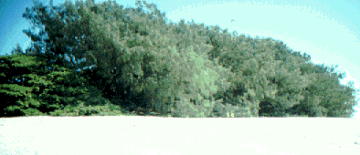 The shrub and tree zone is dominated
by the screw pine (Pandaneus tectorius) and
the coastal she-oak (Casuarina equisetfolia) whose nitrogen-fixing ability
gives it a decided advantage.
The shrub and tree zone is dominated
by the screw pine (Pandaneus tectorius) and
the coastal she-oak (Casuarina equisetfolia) whose nitrogen-fixing ability
gives it a decided advantage.
The third zone is dominated by Pisonia grandis, large soft-wood trees up to 20 m in height. Here the black noddies nest in dense groups. There is a tendency for each zone to expand seawards over time.
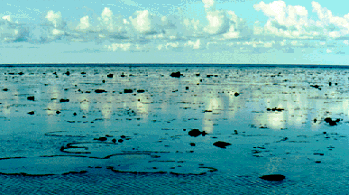 Lady Elliot has a
shallow inner reef extending out 300 meters from the shoreline. At
this point there is a narrow rubble crest of 30 meters or so and beyond
that deeper water coral gardens and the Pacific. The shallow inner reef
and easily accessible deeper water made it an ideal instructional
laboratory.
Lady Elliot has a
shallow inner reef extending out 300 meters from the shoreline. At
this point there is a narrow rubble crest of 30 meters or so and beyond
that deeper water coral gardens and the Pacific. The shallow inner reef
and easily accessible deeper water made it an ideal instructional
laboratory.
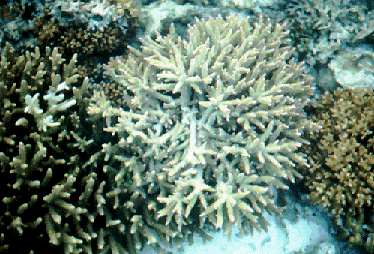 Three different species of branching coral compete for space in the reef flat. The
corals' color comes from the symbiotic single-celled plants called zooxanthellae
which lives within its tissue.
Three different species of branching coral compete for space in the reef flat. The
corals' color comes from the symbiotic single-celled plants called zooxanthellae
which lives within its tissue.

Phylum: Echinodermata Class: Asteroidea Species: Linckia laevigata "Sea Star" or "Starfish"Among the most conspicuous invertebrates on the reef are the echinoderms (from the Greek for "spiny skin") such as the starfish (or sea stars) and the sea urchins. The most prominent of the starfish (asteroidea) are the bright blue Linckia laevigata which are quite common in the reef flat.

Phylum: Echinodermata Class: Asteroidea Species: Nardoa novacaledoniae "Sea Star" or "Starfish"Somewhat less common, though by no means rare, are the mustard-yellow starfish Nardoa novacaledoniae which are also found in the reef flat.

Phylum: Echinodermata Class: Asteroidea Species: Culcita novaguineae "Pincushion Star"The pincushion star is a common inhabitant of shallow patch, barrier, and fringing reefs. This individual was found in the inner reef flat at Lady Elliot. reef flat.
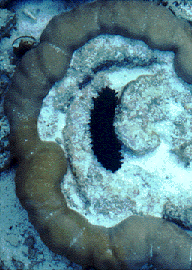
Phylum: Echinodermata Class: Holothuroidea Species: Holothuria leucospilota "Sea Cucumber"Holothurians are called "sea cucumbers in part because of their widespread use in Asia as a base for soups. One of the most common species on the reef flat at Lady Elliot is the sea cucumber Holothuria leucospilota. In some areas, the reef can seem to be covered by these or other holothurians. Most species feed on the rich organic film that covers sandy surfaces.
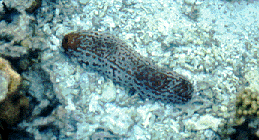
Phylum: Echinodermata Class: Holothuroidea Species: Bohadschia argusA second type of sea cucumber, less common at Lady Elliot, is Bohadschia argus. "Sea Cucumber"
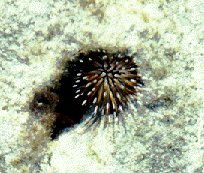
Phylum: Echinodermata Class: Echinoidea Species: Echinometra mathaei "Sea Urchin"This common sea urchin, Echinometra mathaei, has simple spines with white tips and is usually found in holes bored in coral.
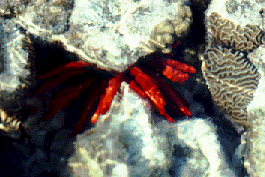
Phylum: Echinodermata Class: Echinoidea Species: Heterocentrotus mammillatus "Slate Pencil Urchin"Hiding in crevices, the spectacular Heterocentrotus mammillatus, or slate pencil urchin, with its many flattened spines was only occasionally seen in the reef flat. They may be up to 200 mm in diameter.
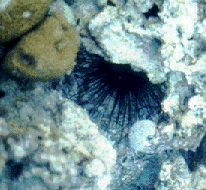
Phylum: Echinodermata Class: Echinoidea Species: Diadema savignyi "Sea Urchin"This particular urchin, Diadema savignyi, hides under rocks or coral during the day but is active at night and was seen during the night snorkeling. It has poisonous spines.
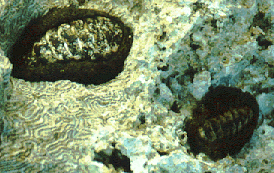
Phylum: Mollusca Class: Polyplacophora Family: Chitonidae "Chiton"Chitons are an ancient group of molluscs that usually graze on algae. In the Great Barrier Reef, they are often found in intertidal pools or under rocks at the shore's edge.

Phylum: Chordata Subphylum: Vertebrata Superclass: Gnathostomata Class: Osteicthyes Family: Chaetodontidae Species: Chaetodon lineolatus "Lined Butterflyfish?"Butterflyfishes are known for their beautiful color patterns and graceful appearance. Many feed on live corals. (Photo: C. Parker '98 )

Phylum: Chordata Subphylum: Vertebrata Superclass: Gnathostomata Class: Osteicthyes Family: Scaridae Species: Scarus sp. "Parrotfish"In parrotfish, all teeth are fused to form a distinctive beak-like structure. They consume considerable amounts of coral rock while feeding. It is ground to a fine powder by special teeth in the throat and voided with the feces. Individuals are capable of female to male sex change.

Phylum: Chordata Subphylum: Vertebrata Superclass: Gnathostomata Class: Osteicthyes Family: ?? Species: ?? "???"Unidentified fish.

Phylum: Chordata Subphylum: Vertebrata Superclass: Gnathostomata Class: Elassmobranchii Order: Myliobatiformes Species: Manta birostris "Manta Ray"The manta ray can grow to 7 m across and weigh over 3 tons. It has a black dorsal surface and white underneath with large cephalic flaps on either side of the head. It feeds entirely on plankton and small fish. Other rays seen at Lady Elliot included the shovelnose and the blue-spotted rays. Additional information on manta rays. (Photo: J. Chiusolo '99).

Phylum: Chordata Subphylum: Vertebrata Superclass: Gnathostomata Class: Elassmobranchii Species: Negaprion acutidens? "Lemon Shark?"The manta ray can grow to 7 m across and weigh over 3 tons. It has a black dorsal surface and white underneath with large cephalic flaps on either side of the head. It feeds entirely on plankton and small fish. Other rays seen at Lady Elliot included the shovelnose and the blue-spotted rays. Additional information on manta rays. (Photo: J. Chiusolo '99).

Phylum: Chordata Class: Reptilia Order: Testudines Species: Caretta caretta "Loggerhead Turtle"Carapace: 70 to 110 cm. Less abundant that the green turtle, the loggerhead turtle breeds and nests along the Bundaberg coast, including Lady Elliot Island. They feed on crabs and shellfish. The population in Queensland has declined by about 50 percent in the last decade. (Photo: B. Wood 98).

Phylum: Chordata Class: Reptilia Order: Testudines Species: Chelonia mydas "Green Turtle"Carapace: 40 to 120 cm and highly domed. Green turtles are relatively common. They feed on seagrass and algae and breed in rookeries including Lady Elliot Island. They are more common at Heron Island where this photo was taken.
Additional information on
Marine
Turtles in Australia.

Phylum: Chordata Class: Aves Family: Phaethontidae Species: Phaethon rubricauda "Red-tailed Tropic Bird"Lady Elliot is a breeding ground for the endangered red-tailed tropic bird. Females usually produce a clutch of one egg (rarely two) which are incubated by both parents for about 40 days. Young are fed with fish from their parents' bills for a period of two to three months. In recent years, only one or two pairs have nested on LEI

Phylum: Chordata Class: Aves Family: Haematopodidae Species: Haematopus longirostrisBoth the pied (shown here) and the sooty oystercatchers were common on the shore at Lady Elliot.

Phylum: Chordata Class: Aves Family: Laridae Species: Anous minutus "White-capped Noddy" "Black Noddy"330--360 mm. The white-capped noddy is one of the world's most numerous species as anyone who has visited Lady Elliot can attest. The nest shown here is quite typical: a platform of leaves on a branch of a Pisonia or Pandanus tree. A clutch usually consists of a single egg. Their diet consists of anchovies, hardyheads, squid, and krill and the they may hunt in flocks containing up to 3000 birds.
 Before starting field projects, Professor Tibbetts of the UQ School of Marine Science
led a day reefwalk to orient students to the fauna of the inner reef including
holothuroidea (sea cucumbers), echinoidea (sea urchins), asteroidea
(starfish), mollusks, corals, fish, small sharks, blue-spotted rays, and
octopi. The contrast with Stradbroke was obvious.
Before starting field projects, Professor Tibbetts of the UQ School of Marine Science
led a day reefwalk to orient students to the fauna of the inner reef including
holothuroidea (sea cucumbers), echinoidea (sea urchins), asteroidea
(starfish), mollusks, corals, fish, small sharks, blue-spotted rays, and
octopi. The contrast with Stradbroke was obvious.
 Student Journal Excerpt
Student Journal Excerpt
Additional items seen on the reef walk were brittle stars, cone shells (Conus ebraues), and chitons which are found on the rubble shore.
Drawings: S. Flanders '98
 Jason Chiusolo '99 uses a sea scope to collect data
for a project on the distribution of sea stars in the
inner reef area.
Jason Chiusolo '99 uses a sea scope to collect data
for a project on the distribution of sea stars in the
inner reef area.
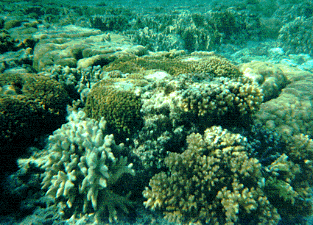 Day snorkeling beyond the reef crest provided an orientation to the fauna of the
outer reef, including black-tipped and white-tipped sharks, manta and
eagle rays, green and loggerhead turtles, coral cod, sweetlips, tang,
wrasse, parrot-fish, damsel-fish, butterfly-fish, angel-fish, flute-mouths,
cleaner-fish, and moray eels.
Day snorkeling beyond the reef crest provided an orientation to the fauna of the
outer reef, including black-tipped and white-tipped sharks, manta and
eagle rays, green and loggerhead turtles, coral cod, sweetlips, tang,
wrasse, parrot-fish, damsel-fish, butterfly-fish, angel-fish, flute-mouths,
cleaner-fish, and moray eels.
 Snorkeling at dusk in the inner reef flat illustrated the "changing of the guard"
as the more colorful fish active in the day went into hiding and
the silver and "transparent" fish started their nighttime feeding.
There is even a switch over in the activity of sea urchins as
Diadema savignyi
(shown here) with its long spines becomes increasingly active.
Snorkeling at dusk in the inner reef flat illustrated the "changing of the guard"
as the more colorful fish active in the day went into hiding and
the silver and "transparent" fish started their nighttime feeding.
There is even a switch over in the activity of sea urchins as
Diadema savignyi
(shown here) with its long spines becomes increasingly active.
 Students collecting data in the reef flat area
for their individual projects on Lady Elliot Island.
Students collecting data in the reef flat area
for their individual projects on Lady Elliot Island.
 Mike Conn '97, Rebecca Price '97, and Todd Pauliny '97 report
on a project involving crab behavior.
Groups reported on the projects they completed at Lady Elliot, many of which
involved a comparison study at Stradbroke Island. Topics included
Mike Conn '97, Rebecca Price '97, and Todd Pauliny '97 report
on a project involving crab behavior.
Groups reported on the projects they completed at Lady Elliot, many of which
involved a comparison study at Stradbroke Island. Topics included
 Species competition and partitioning of resources were themes of the lectures
at Lady Elliot.
Here two species of coral compete for space in the reef flat with a giant clam.
Species competition and partitioning of resources were themes of the lectures
at Lady Elliot.
Here two species of coral compete for space in the reef flat with a giant clam.
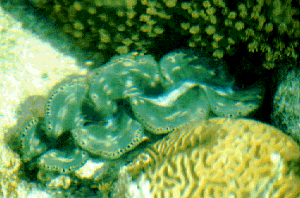 Not all relationships on the reef flat are competitive.
The dinoflagellate zooxanthellae and coral or clams are symbionts.
The mantle of this clam Tridacna crocea
is colored by enclosed zooxanthellae. The green
and brown corals are also colored by their symbiotic zooxanthellae. The
corals depend on the photosynthetic activity of the zooxanthellae as a source of
carbohydrates. The zooxanthellae obtains protection from the coral.
Not all relationships on the reef flat are competitive.
The dinoflagellate zooxanthellae and coral or clams are symbionts.
The mantle of this clam Tridacna crocea
is colored by enclosed zooxanthellae. The green
and brown corals are also colored by their symbiotic zooxanthellae. The
corals depend on the photosynthetic activity of the zooxanthellae as a source of
carbohydrates. The zooxanthellae obtains protection from the coral.
 Group photo just before departure back to the mainland.
Group photo just before departure back to the mainland.
